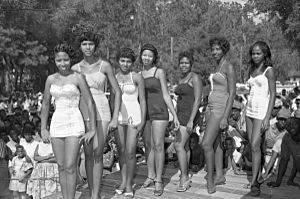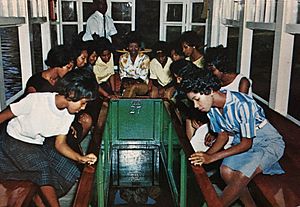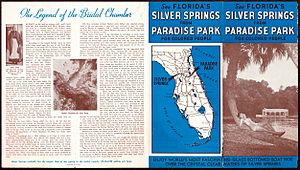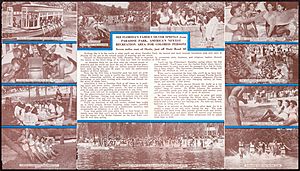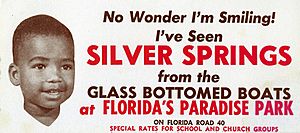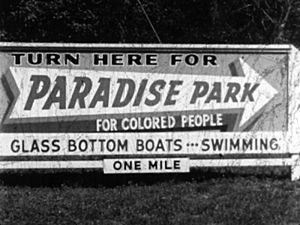Paradise Park, Florida facts for kids
Paradise Park was a special place in Florida. It was a fun park for African American families. This was during a time when many places in the United States were segregated. Segregation meant that Black and white people were kept separate.
Paradise Park was near Silver Springs, close to Ocala, Florida. It was the only park in the area for African Americans. It opened in 1949 and closed in 1969. This was soon after Silver Springs started allowing all people, no matter their race.
Contents
What Was Paradise Park Like?
Paradise Park offered many exciting things to do. It had glass-bottom boats, just like Silver Springs. These boats let you see under the water! There were also "jungle cruises" and a petting zoo.
The park had a dance hall with a jukebox. People could listen to music and dance. There were also live performers. For sports, visitors could play softball or horseshoes. The park also had a sandy beach with lifeguards.
A Place for Everyone
Paradise Park was one of only three beaches in Florida open to African Americans at the time. Entry to the park was free. However, swimming cost 35 cents. This price included a towel and a place to store your clothes.
Many people visited Paradise Park. About 100,000 visitors came each year. They traveled from far away, even from New York and California. Sometimes, the park was very full. One day, 30 buses were counted in the parking lot. On another day, 247 cars were there! Brochures for the park were given out in states like Georgia and Alabama. In 1953, Ebony magazine called it "the newest and largest recreational facility for Negroes in the South."
Fun Activities and Special Guests
Paradise Park was a popular spot for many events. Churches held large baptisms there. Families often had picnics. Preachers and choirs would hold sunrise services, especially on Easter.
Holiday Celebrations
The park celebrated holidays in fun ways. For example, there were Easter egg hunts. At Christmas, Santa Claus would arrive on a glass-bottom boat. He would give out candy, nuts, and fruit to the children.
Ross Allen's Reptile Exhibit
A famous animal expert, Ross Allen, had a reptile exhibit at the park. It was similar to his exhibit at Silver Springs. His exhibit had many animals. These included dozens of alligators and hundreds of snakes. There were also monkeys, deer, birds, and turtles. Sometimes, there were even lions and tigers! Ross Allen was known for his snake shows. He would teach people about snakes and even "milk" them for venom.
Special Events and Visitors
Paradise Park also hosted special events. On Labor Day, there was a beauty pageant. A local American Legion group sponsored it. In 1949, Mildred Jones was crowned the first Miss Paradise Park.
The Future Farmers of America held their meetings there. Famous musician B. B. King once visited the park. Mary McLeod Bethune, a well-known educator, also visited. She felt sad that the park had to be segregated. There was even a special day for Bethune-Cookman College. All the money made that day went to the college.
The Park's End
In 1967, Silver Springs began to allow all visitors, regardless of race. Paradise Park stayed open for a little longer. In its last season, 1968–1969, it was only open on Saturdays, Sundays, and holidays. The park quietly closed in 1969.
Today, the area where Paradise Park once stood is covered by plants and trees. However, many people who worked or visited there remember it fondly. They often say, "Paradise Park was our roots."
Images for kids


